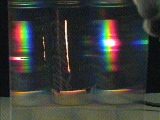 Diffraction grating placed in front of a slit of light
from an incandescent bulb gives a rainbow.
Diffraction grating placed in front of a slit of light
from an incandescent bulb gives a rainbow.
|
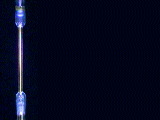 Excitation of hydrogen gas by high voltage electrons
yields light of specific colors when observed through a diffraction
grating.
Excitation of hydrogen gas by high voltage electrons
yields light of specific colors when observed through a diffraction
grating.
|
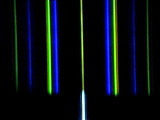 Excitation of mercury vapor by high voltage electrons
yields light of specific colors when observed through a diffraction
grating. The same colors are observed to each side of the central
source.
Excitation of mercury vapor by high voltage electrons
yields light of specific colors when observed through a diffraction
grating. The same colors are observed to each side of the central
source.
|
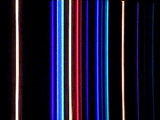 Excitation of a gas by high voltage electrons yields
light of specific colors when observed through a diffraction
grating. Gases used are (1) hydrogen, (2) helium, (3) mercury,
and (4) nitrogen. N2 exhibits broader lines due to
molecular vibrations and rotations in addition to electronic
transitions.
Excitation of a gas by high voltage electrons yields
light of specific colors when observed through a diffraction
grating. Gases used are (1) hydrogen, (2) helium, (3) mercury,
and (4) nitrogen. N2 exhibits broader lines due to
molecular vibrations and rotations in addition to electronic
transitions.
|
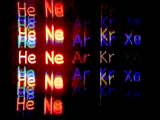 Diffraction grating placed in front of excited noble
gases. The grating is oriented so that diffraction occurs vertically.
Diffraction grating placed in front of excited noble
gases. The grating is oriented so that diffraction occurs vertically.
|
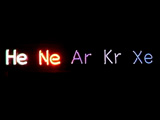 Diffraction grating placed in front of excited noble
gases, one gas at a time. The grating is oriented so that diffraction
occurs horizontally.
Diffraction grating placed in front of excited noble
gases, one gas at a time. The grating is oriented so that diffraction
occurs horizontally.
|
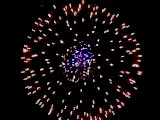 Excitation by chemical explosion.
Excitation by chemical explosion.
|
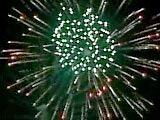 Excitation by chemical explosion.
Excitation by chemical explosion.
|
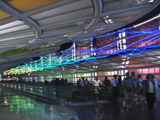 How do you think these colors are produced?
How do you think these colors are produced?
|
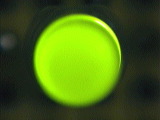 Some of the colors available from a tricolor LED.
Some of the colors available from a tricolor LED.
|